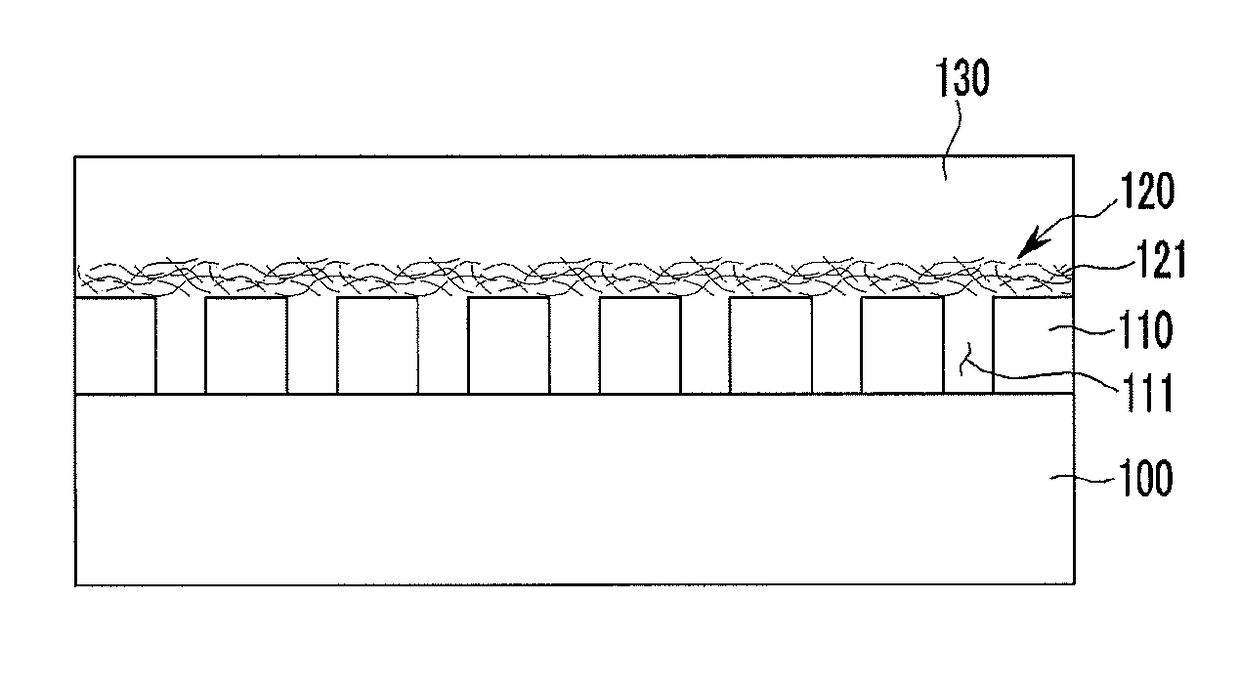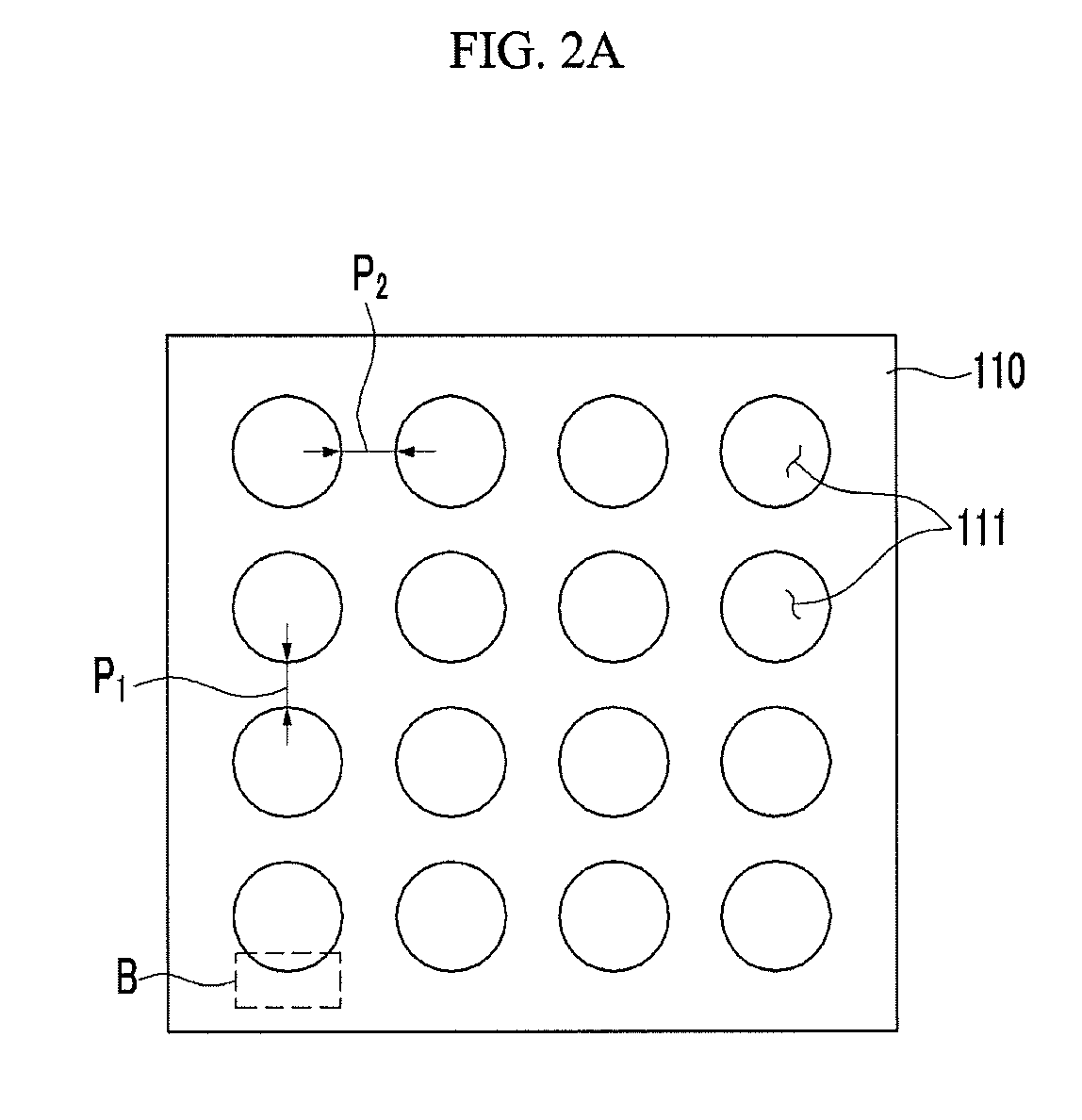Transparent electrodes and electronic devices including the same
a technology of transparent electrodes and electronic devices, which is applied in the direction of carbon-silicon compound conductors, semiconductor devices, material nanotechnology, etc., can solve the problems of limited conductivity and flexibility of ito as currently used, cost issues, etc., and achieves improved light transmission, reduced sheet resistance, and suitable mechanical flexibility
- Summary
- Abstract
- Description
- Claims
- Application Information
AI Technical Summary
Benefits of technology
Problems solved by technology
Method used
Image
Examples
example 1
[0125]A transparent electrode of Example 1 may be manufactured by the following method.
[0126][1] A graphene monolayer is deposited on one surface of a copper (Cu) foil by a chemical vapor deposition (CVD) method. After a polymethyl methacrylate (hereinafter, PMMA) layer is formed on the deposited graphene monolayer, the copper foil is removed by etching. Then, a PET-graphene monolayer stacked body may be obtained by transferring the graphene monolayer on which the PMMA layer has been formed on a PET substrate, and then the PMMA layer is removed.
[0127][2] Then, a photoresist layer is formed on the graphene monolayer in the PET-graphene monolayer stacked body, and then is exposed and developed by disposing a mask including circular hole patterns on the photoresist layer. Then, a first layer, which is a first conductive layer including a graphene mesh structure may be formed on the PET substrate by removing the residual photoresist and then etching the graphene monolayer along the deve...
example 2
[0135]A transparent electrode is manufactured by an identical method to that of Example 1 except that a first layer including a graphene mesh structure, which is a first conductive layer, is formed on a substrate, and then about 3 mg of AuCl3 as a dopant and about 1 milliliter (mL) of nitromethane as solvent are mixed, and the thus-obtained mixture is doped onto the graphene mesh structure. A content of the doped AuCl3 is about 10 wt % with respect to a total weight of the first layer.
[0136]A sheet resistance of the graphene mesh structure doped with AuCl3, which is formed in Example 2 is measured by performing a four-point probe method on an upper surface thereof using the aforementioned LORESTA-GP MCP-T610 with ESP-type probes MCP-TP08P manufactured by MITSUBISHI CHEMICAL ANALYTECH, and the result thereof is shown in Table 1.
example 3
[0137]A transparent electrode is manufactured by the identical method to that of Example 1 except that a first layer including a graphene mesh structure, which is a first conductive layer is formed on a substrate, and then volatile HNO3 as a dopant is adsorbed and doped onto the graphene mesh structure in an atmosphere at a room temperature for about 10 minutes. A content of the doped HNO3 is about 0.01 wt % with respect to a total weight of the first layer.
[0138]A sheet resistance of the graphene mesh structure doped with HNO3, which is formed in Example 3, is measured by performing a four-point probe method on an upper surface thereof using the aforementioned LORESTA-GP MCP-T610 with ESP-type probes MCP-TP08P manufactured by MITSUBISHI CHEMICAL ANALYTECH, and the result thereof is shown in Table 1.
[0139]
TABLE 1Sheet ResistanceCoverage (%)Dopant(Ω / sq)Example 142Not Included1560Example 242AuCl3518Example 342HNO3337
[0140]Referring to Table 1, it can be seen that, in the case of Examp...
PUM
| Property | Measurement | Unit |
|---|---|---|
| sheet resistance | aaaaa | aaaaa |
| width | aaaaa | aaaaa |
| thickness | aaaaa | aaaaa |
Abstract
Description
Claims
Application Information
 Login to View More
Login to View More - R&D
- Intellectual Property
- Life Sciences
- Materials
- Tech Scout
- Unparalleled Data Quality
- Higher Quality Content
- 60% Fewer Hallucinations
Browse by: Latest US Patents, China's latest patents, Technical Efficacy Thesaurus, Application Domain, Technology Topic, Popular Technical Reports.
© 2025 PatSnap. All rights reserved.Legal|Privacy policy|Modern Slavery Act Transparency Statement|Sitemap|About US| Contact US: help@patsnap.com



